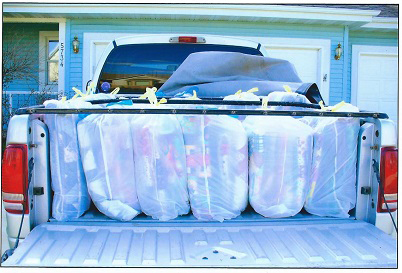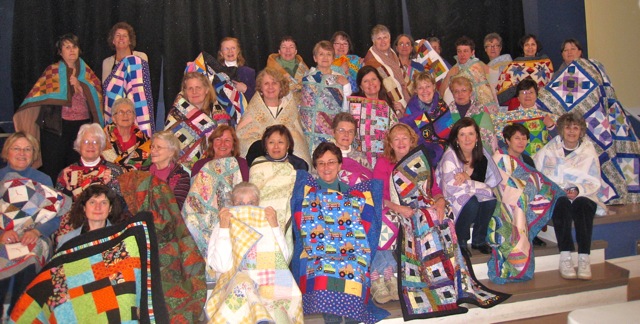BACK TO STORIES
Exhibitions of Health-Realted Quilts
United States
The fall 2015 production of charity quilts packed and ready to deliver, made by the Black Gold Quilt Patch Guild of Leduc, Alberta, Canada
Photo by Cecile Sigfuson

Charity quilts made for Operation Sunggles by quilt guilds in southeast Wisconsin.
Photos by Barbara Vallone

Concord Piecemakers Quilt Guild of Middlesex, Massachusetts, February 2013, at their annual Quilt-a-Thon.
Photo courtesy of Sheila Macauley.
Groups of quiltmakers who make charity quilts often temporarily display their work at their meeting places or a local church, library, or other community center before the quilts are given to the intended individual recipients or to the organizations which, in turn, will distribute them. Many images can be found in newspaper accounts or on the Internet, of quilts displayed informally draped over church pews or hung on clotheslines or over fence rails. Makers, members of the group the makers belong to, and members of the general community are able to see the quilts and these public displays, especially when accompanied by presentation ceremonies. These are often occasions when the quiltmakers receive informal and formal appreciation for their art and the charity activity in which they are engaged.
Quilts made for charitable purposes are public declarations of political stances, values and beliefs, and priorities of philanthropic action; and, as stated in Matthew 7:16, “by their work they shall be known,” quiltmakers find agency and recognition in their work. Women’s studies scholar Karen Smith has commented on the politics of public displays of quilts, “Though quilts are utilitarian in origin, their circulation and display take them far beyond the home—to art galleries, history museums, state fairs, quilt shows, and philanthropic auctions. As they move, individuals and institutions make significant intellectual and emotional investments in how quilts are classified, judged, and valued. In this highly politicized work, individuals and institutions shape public culture through debates about quilts’ utility, workmanship, and aesthetics; they create and display quilts to further their cultural heritage, manifest their faith, delineate aesthetic values, reinforce disciplinary boundaries, and elevate their artistic status.” Through the displays of charity quilts, whether it be in local contexts or in exhibitions that tour to widespread venues, the quiltmakers, exhibition organizers, staff of exhibition venues, and the media that write about these displays make strong statements of the aesthetic, social, political, educational, and cultural value and meaning of the work.
Written by MacDowell, Marsha;Luz, Clare;Donaldson, Beth (2017)
MacDowell, Marsha; Luz, Clare; Donaldson, Beth. Quilts and Health. University of Indiana Press, 2017. Page 122.
Quilts and Health
-
Quilts and Health Documentation Project
Michigan State University
Load More